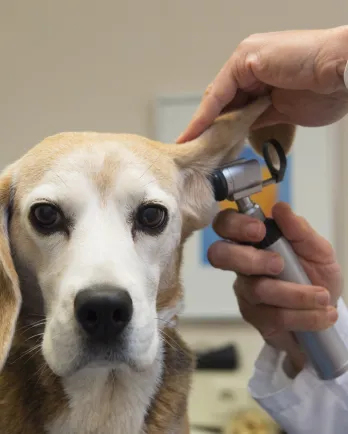Four Steps to Keep Your Dog’s Ears Healthy by Lindy Callahan
Whether your dog is genetically prone to ear infections or just loves getting in the water, it never hurts to monitor his ears for signs of inflammation. Prevention is the best approach to total ear health. With that in mind, it is important that we know what to look out for and how to care for the ears properly. Here are a few steps you can take to keep your dog’s ears clean and itch-free.
1. Know the Basics
Anatomy - A dog’s ears are quite different than our human ears. Their ear canals form a shape that resembles an upside down horn. This makes it more difficult for debris to get out as it must work its way upward.
Risk Factors - Anatomy alone leaves all breeds at some risk of developing ear inflammation. However, some breeds are more susceptible to ear infections. This can be due to more wax producing cells in the breed, such as in the Labrador Retriever, or a narrower ear canal, as in the case of Chow Chows. Allergies, hypothyroidism, living in a humid environment, parasites, and frequently swimming or bathing can also contribute to ear problems. The best policy is to include ear care as part of your dog’s weekly grooming and watch for signs of trouble so it can be treated right away before it become more serious.
2. Watch for Warning Signs
A dog might not be able to talk, but you will know if their ears are bothering them. Ear problems can crop up literally overnight, so don’t delay getting care for your dog if you notice any signs of ear trouble. If you see any of the following symptoms, it is time for a trip to the vet:
- Frequent scratching or pawing at ears, head shaking or rubbing of ears against a hard surface
- Discharge
- Odor
- Constant tilting of the head or drooping of the ear downwards
- Redness or swelling
- Crusty skin inside or around the ears
- Hair loss around the ears
- Excessive dark earwax
3. Talk to Your Vet
When in doubt, your veterinarian is the person you want to talk to. Give them a complete history and then allow a full examination. The vet can take a sample of wax from your dog’s ear to determine if something is wrong and what the proper course of treatment will be. Sometimes minor inflammation just requires a cleaning or two, while full infections may require a prescribed medication to get rid of the issue entirely. Ear infections are quite painful for your dog, and getting relief quickly is the key to treating them successfully.
4. Make Ear Cleaning Part of the Grooming Routine
Taking a look inside of your dog’s ears every now and again is a good idea. A gentle ear cleaning whenever they have a bath can be helpful and assist in keeping future problems at bay. Consult with your vet for a mild cleaning solution that would be ideal for your pet. You want a very gentle solution made specifically for ear cleaning and without any alcohol, hydrogen peroxide, vinegar, or other potentially irritating ingredients. Some cleaning solutions dry the ear canal, some break down ear wax, and others even do both. For a routine cleaning, follow these steps:
- Have your dog lie down on his side on a comfortable surface, such as his bed, where you can reach him easily.
- Now open his ear flap (if he has drop ears) and gently insert a few drops of the cleaning solution into the ear canal.
- Massage the base of your dog’s ear to let the solution move in. If he shows any signs of pain at this point, stop immediately and consult your vet.
- After a minute or two of massaging let your dog get up to shake it off.
- Use a large cotton ball (**never use a Q-tip as they could potentially cause damage**) to clean any excess solution or debris out of the ear.
- Switch sides and repeat.
- Give him a treat for being such a good dog.
Just by knowing what to look out for and by taking a few steps to prevent inflammation you can help your dog spend less time itching and more time enjoying the things they love most.
This is an informational article only. Please contact your veterinarian for advice.
Sources:
http://www.vetmed.wsu.edu/ClientED/dog_ears.aspx
http://www.banfield.com/pet-health-resources/pet-health-concerns/other-concerns/do-i-need-to-clean-my-dog-s-ears



